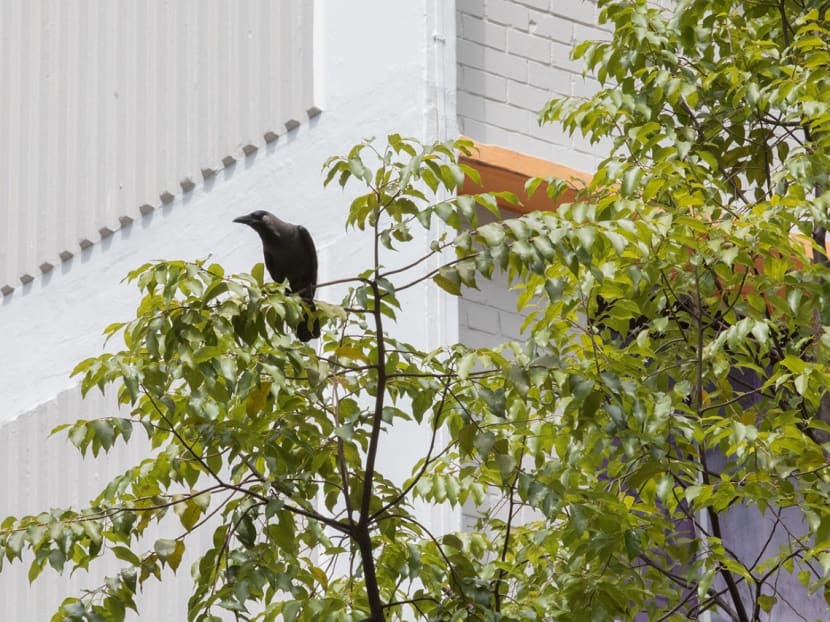Explainer: What's behind attacks by crows and how the numbers of these birds are being managed
SINGAPORE — A Bishan resident has learnt to live with the constant flocks of crows around his public housing block, which was the scene of widely publicised crow attacks in mid-February this year.

A crow on a tree near Block 110 Bishan Street 12, pictured on Feb 19, 2023.
- In a widely publicised incident in February 2023, crows in Bishan attacked 10 people in 20 minutes
- TODAY asked wildlife experts what can be done to manage crows' behaviour
- They said that people should learn to behave appropriately when encountering wildlife such as crows
- Strategies for co-existing with crows range from residents living near crows adjusting their behaviour to bird-proofing bin centres
SINGAPORE — A Bishan resident has learnt to live with the constant flocks of crows around his public housing block, which was the scene of widely publicised crow attacks in mid-February this year.
Mr Lim, 40, who declined to give his full name, told TODAY in Mandarin: “They come near my head and I just swat them away. I don’t want to bother them too much.”
Media reports at the time stated that crows attacked 10 people in 20 minutes along Bishan Street 12 on Feb 13. Crow attacks were also reported along Hougang Avenue 8 on Feb 17 and Serangoon Avenue 3 on March 7.
It might seem that this recent spate of crow attacks came out of nowhere, but they have been a recurring issue over recent years.
The National Parks Board (NParks) said earlier this year that it received an average of 3,000 to 4,000 cases of crow-related feedback each year from 2020 to 2022.
The feedback was related to complaints such as noise and feeding habits. Crow attacks accounted for 10 per cent of the feedback, CNA reported.
TODAY spoke to wildlife experts to learn more about why crows sometimes attack people, the size of the crow population here and what steps are being taken to manage the birds.
HOW MANY CROWS ARE IN SINGAPORE?
Mr How Choon Beng, director of wildlife management and outreach at NParks, said: “House crows are not native and are an invasive species in Singapore, posing a threat to our native biodiversity.”
Without any other species to control the crow population, it can spiral out of control, causing ecological and environmental damage, Mr How added.
Ms Ariana Loehr, Asia's communications officer at Birdlife International, said that as an invasive species, the crow’s predators and its competitors for resources have largely died out.
Birdlife International is a charity with a network of scientists and volunteers who help to track, analyse, conserve and study bird species around the world.
Ms Loehr added: "Because crows thrive in human-oriented environments, the crows have adapted well to life in urban areas like Singapore.
“Perhaps it’s because they can forage through trash, or they can come up to you really closely when you’re eating at the hawker centre.”
The crow population here has risen over recent years, though off a fairly low base.
In a yearly bird census by the Nature Society Singapore's bird group, it found that the crow population had more than doubled in the six years from 2015 to 2020, from 103 birds to 256 birds across a sample of sites.
Mr Tan Gim Cheong, the bird group's chairman, said that the team had not noted any increase in crow attacks here, despite the rise in the crow population.
“Whether this is a fact or due to a lack of reporting is an open question,” he said. “If not for media coverage, the incident in Bishan might not be widely known.”
Avian biology PhD candidate David Tan said that it is important to understand crows' behaviour in order to co-exist with these birds.
“Living harmoniously with bird populations means understanding their behaviour, but also understanding that there are appropriate and inappropriate ways of behaving around them,” he added.
WHY DO CROWS ATTACK?
Crows have one main reason for attacking — feeling threatened, the experts explained.
“Likewise, birds will not normally approach humans closely unless they feel humans are an immediate threat — in which case it would be wise to back off — or if it has been habituated to humans, perhaps through feeding.Avian biology PhD candidate David Tan”
“A crow will not attack a human unless it feels that humans are a threat to it or its offspring,” Mr David Tan said.
“I once encountered a very aggressive crow while walking near MacPherson Road.”
“It was only when I saw a baby koel on the ground did I realise that the crow was simply protecting its young."
The Asian koel is a brood parasite, which means that it tricks other birds such as house crows into thinking that the koel young is the crow's own.
“Likewise, birds will not normally approach humans closely unless they feel humans are an immediate threat — in which case it would be wise to back off — or if it has been habituated to humans, perhaps through feeding,” he added.
Agreeing on this point was Ms Anbarasi Boopal, co-chief executive officer of the Animal Concerns Research and Education Society (Acres).
“We still have incidents involving crows defending their nest or young. That proves that removing the crows is not always a solution to the 'crow attacks', as this is a defensive behaviour commonly observed in many wild animals,” she said.
“When they have offspring, they will do all it takes to defend their nest or a fledgling, which is learning to fly and be an adult eventually.”
These experts suggested that people concerned about crow attacks should avoid unnecessary panic, or even to avoid a route temporarily when a bird's nest is sighted or when a crow is sighted with its young.
STRATEGIES TO MANAGE CROW POPULATION
While the most attention-grabbing behaviour of crows is their attacks on people, their noise is another frequent gripe heard by NParks.
To this, Mr David Tan said: “One thing we as Singaporeans may have to adapt to is the fact that birds will make noise, especially early in the morning, and if it’s not the koel making noise, it’s going to be bulbuls or mynahs or kingfishers.”Another problem is crows feeding on scraps of food.
To combat this, methods such as centralised tray return points at hawker centres help to cut down the amount of unattended food left on tables that often enable crows to scavenge on them.
Mr David Tan conducted a study in 2012 on the centralised tray return station at the National University of Singapore and noted that the house crow population is incredibly small, detecting only one crow over a three-month survey.
Reducing available food scraps is part of NParks’ broader strategy to manage the crow population here.
Other techniques include habitat modification, population control strategies such as nest removal and crow trapping, and studies to understand crows' roosting patterns and movements.
Ms Anbarasi said that another technique is tree pruning, since crows nest in the dense crowns of trees.
The experts who spoke to TODAY had more ideas to manage the crow population. Ms Anbarasi suggested steps such as bird-proofing bin centres to ensure that urban food waste does not contribute to their population.
Mr David Tan also suggested planting taller trees away from residents’ windows to reduce interactions between crows and residents. “However, this will likely take years to come to fruition,” he said.
As the authorities work to manage the crow population, Ms Anbarasi said that it was important for residents to understand the birds' behaviour.
“While we empathise that it can be a scary experience to many people when a crow swoops in unexpectedly, we also acknowledge that we need to manage their population, but in a humane manner."
Most good and ethical wildlife management practices begin with altering human behaviour first, then modifying habitat and infrastructure, she added. And when it all does not work, then to interfere "at the animal's level".
Culling and euthanising crows are some ways that have been used by the authorities to curb their numbers, apart from removing nests, pruning nearby trees and trapping crows.
CORRECTION: An earlier version of the article stated that a yearly bird census found that across the country, the number of crows grew from 103 in 2015 to 256 in 2020. This is incorrect, as the census only reflects the crow population across a sample of sites. We are sorry for the error.











